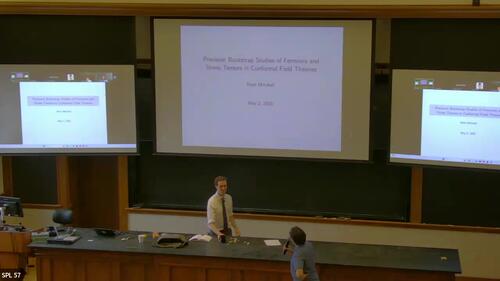
On May 2, Matthew Mitchell successfully defended the thesis, “Precision Bootstrap Studies of Fermions and Stress Tensors in Conformal Field Theories” (advisor: David Poland).
Mitchell explains, “My research uses mathematical tools from particle physics to understand phase transitions. Calculations critical states of matter can be expressed in terms of a conformal field theory (CFT), a type of quantum field theory with additional symmetry. However, if one writes down a random CFT, the theory will not agree with itself, which makes it possible to use self-consistency to constrain CFT observables. My thesis work has led to more precise determination of critical exponents in the Ising model, which describes a broad class of magnets, as well as a new classification of phase transitions involving fermions.”
Mitchell will be starting as a postdoctoral researcher at the University of Pisa, also working on conformal field theories.
Thesis Abstract
Conformal field theories (CFTs) describe a wide variety of scale-invariant phenomena. As CFTs are tightly constrained by symmetry, unitarity, and self-consistency, it is possible to compute rigorous bounds on their observables by translating these constraints into a semidefinite programming problem. This approach, known as the numerical conformal bootstrap, has been used to great success in recent years, and has produced the tightest bounds to-date on the critical exponents of 3d Ising and O(N) models. In this work, we conduct bootstrap studies of spinning operators in several CFTs.
First, we present a numerical bootstrap analysis of the critical 3d Gross–Neveu–Yukawa models, a family of QFTs containing Majorana fermions with an O(N) global symmetry coupled to a scalar. These CFTs arise as universality classes for a variety of condensed matter systems. We show that for N > 1, GNY CFTs possess exactly two relevant scalar operators, which significantly constrains the phase diagrams of fermionic materials with scalar order parameters. We also perform an algebraic classification of GNY-like critical points and compute their parameters perturbatively, laying the groundwork for future bootstrap studies.
Second, we present bootstrap results for mixed correlators of scalars and stress tensors in the 3d Ising CFT. These include much tighter bounds on the Ising model’s critical exponents and OPE coefficients, as well as the first bounds on the scaling dimension of parity-odd operators in its spectrum.